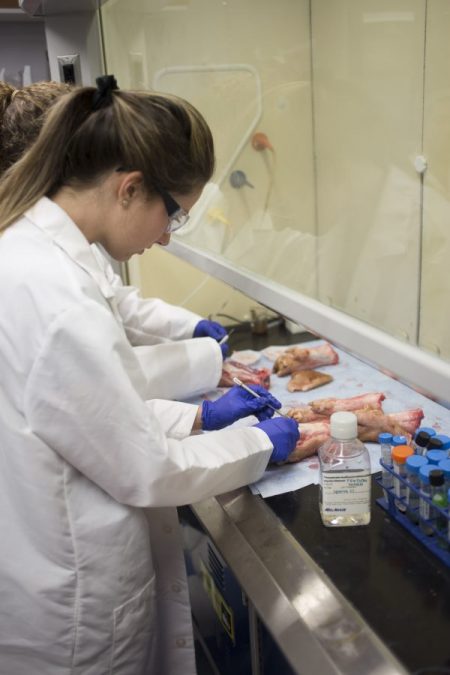
Soft Tissue and Sports Injuries
byNiko Hajimihalis
Division I athletes are among the most athletic people in the world. For college baseball players, the ability to throw and hit baseballs that are traveling more than 90 miles per hour is one of the most difficult feats in the sport. Unfortunately, baseball injuries are a part of the sport. Countless pitchers across the United States suffer from injuries in the elbow region. These ligament and tendon injuries are attributed to the stress and torque of repetitively throwing a baseball. The Exploration into Soft Tissue Sports Injuries: Diagnosis and Prevention Creative Inquiry project hopes to create new tools to accurately assess injuries. They want to assess ligament and tendon injuries, while also studying the forces and stresses that repetitive pitching motions cause on these tissues and muscles.

Students dissect pig ligaments and tendons to use in testing their stretching device.
Led by Dr. Delphine Dean in the Department of Bioengineering, this Creative Inquiry team is approaching the project from multiple directions. In the laboratory, students dissect and preserve pig tendons for use in their research. The tendons and ligaments of pigs are remarkably similar to those of humans, giving the team the opportunity to investigate how stretching pig tendons may correlate with how a human’s tendon stretches.
When both pig and human ligaments are stretched, microtearing occurs. Microtears only happen when consistent, repetitive motion takes place and it increases the likelihood of a complete tear. By studying stretching in pig tendons and ligaments, the Creative Inquiry team is able to gain a better understanding of the relationship between microtearing and more serious injuries.
On the other side of the project, students are engineering a device to help stretch pig tendons.
“This device will cyclically lift and stretch the tendons based off of inputted variables to try and recreate the repetitive motions made in pitching,”
Melissa Judge, a senior bioengineering major, said. The device’s blueprints are done, and students are waiting to finish making the final product in the Watt Center’s Student Makerspace. The team plans on comparing previously collected data with the data that they collect using this device.
Going forward, the team hopes to include the Clemson baseball team in their research. After they validate their results from the laboratory and the use of the mechanical stretching device, the team will submit an Institutional Review Board protocol to use ultrasound technology on the baseball players. Using an ultrasound will enable the students to take images of the joints in athletes and compare density data found in ligaments with and without microtearing.
Sports fans understand that it is incredibly difficult to be a Division I baseball player. What many do not know is how taxing this sport can be on the body. It is this Creative Inquiry team’s hope to educate sports fans, researchers, doctors and others about how we can help prevent injuries in those who put their bodies on the line for the game that they love and that the fans love to watch.


